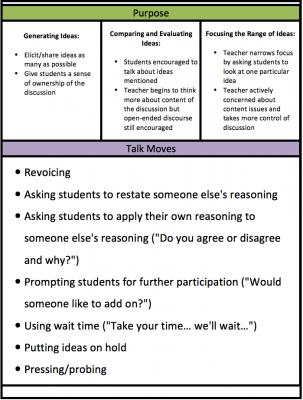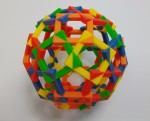[This is part of a series of posts I’m writing as I reflect on another online course I’m taking this summer, Stanford University’s EDUC115N How to Learn Math. Sure, I’m a Science teacher but I have taught Math so I’m familiar with Math instruction. Besides, we do use Math in Science so it’s not like I don’t do any Math with my students and my NB certification is an early adolescent generalist, which means I’m an integrationist at heart.]
I thought it was interesting that Dr. Boaler refers to teacher moves when we were asked to observe a videotaped lesson. I learned them as talk moves, see enclosed poster. Either way, they refer to the same thing so it must just be a British thing. 🙂
In the video the teacher used a strategy to help students understand dividing fractions. The class was divided (sorry) between two possible answers. Now at this point the teacher could have easily told the class which answer was correct, shown them why it was correct, and either move on or have them practice. This model is not very effective.
Instead the teacher exemplified many of the talk moves mentioned in the poster to the left by using a cool strategy. First, and this is a change we all need to make in all content areas, students are encouraged to share their mistakes as well as their correct answers. There’s no fear of sharing mistakes because it’s part of the classroom culture. She showed her students that mistakes are how we learn. The next thing she did was pretty cool, she asked students to do the following when they get an answer to a problem: “convince yourself, convince a friend, convince a skeptic.”
Kids in small groups who get different answers have to do through the convincing before they agree on an answer. The students who shared in the video had reasons for believing their answer was correct and they continued until they convinced those who agreed with them and those who didn’t finally arriving, on their own with some facilitation from the teacher, on which answer was the correct one. It may have taken longer to arrive at the correct response, most of the class period was spent on one rather simple problem but I bet more kids got it at the end of that lesson than they would have had she just told them which answer was correct at the beginning.
In my last post I stated that ability grouping/tracking needs to stop and that teachers can differentiate and help all students learn Math by using best practices. The talk moves mentioned in the poster that’s on this post provides an example of techniques teachers can use in a mixed ability Math class.
The next hurdle to overcome is the Maths we are teaching our children (yes, I like the way the British say it). Textbook math is just not as rich a source for Math content. Most textbook Math is too narrow and focused on closed problems with one right answer to showcase one way of solving the problems. Kids need to be solving real problems that make sense because that will provide the context they need to learn Math.
Here’s an example of a teacher who let her students own a Math problem: When I Let Them Own the Problem.
Another great resource is Dan Meyer’s MakeOver Math segments. Teachers are working together to think up new ways to make Math more available and challenging for kids.
David Wees is another great resource and here’s a cool post: [Three Acts] Stopping Distance Makeover
Dr. Boaler also shared this resource, the Mathematics Assessment Project. It has formative assessment lessons in beta, a few samples for middle and high school. As part of the course I checked out one of their 6th grade lessons and it was a great lesson. They provide the teacher with all the materials you’ll need including possible mistakes the students can make and ideas for feedback to help students figure it out! Looks promising!
So this should get teachers started in visualizing how they can teach mixed ability Math classes if they aren’t already. Next I’ll share the five parts of a growth mindset framework that Dr. Boaler introduced in the course. Isn’t it funny how Assessment for Learning (AfL) has five main strategies and the growth mindset framework has five parts?



















































